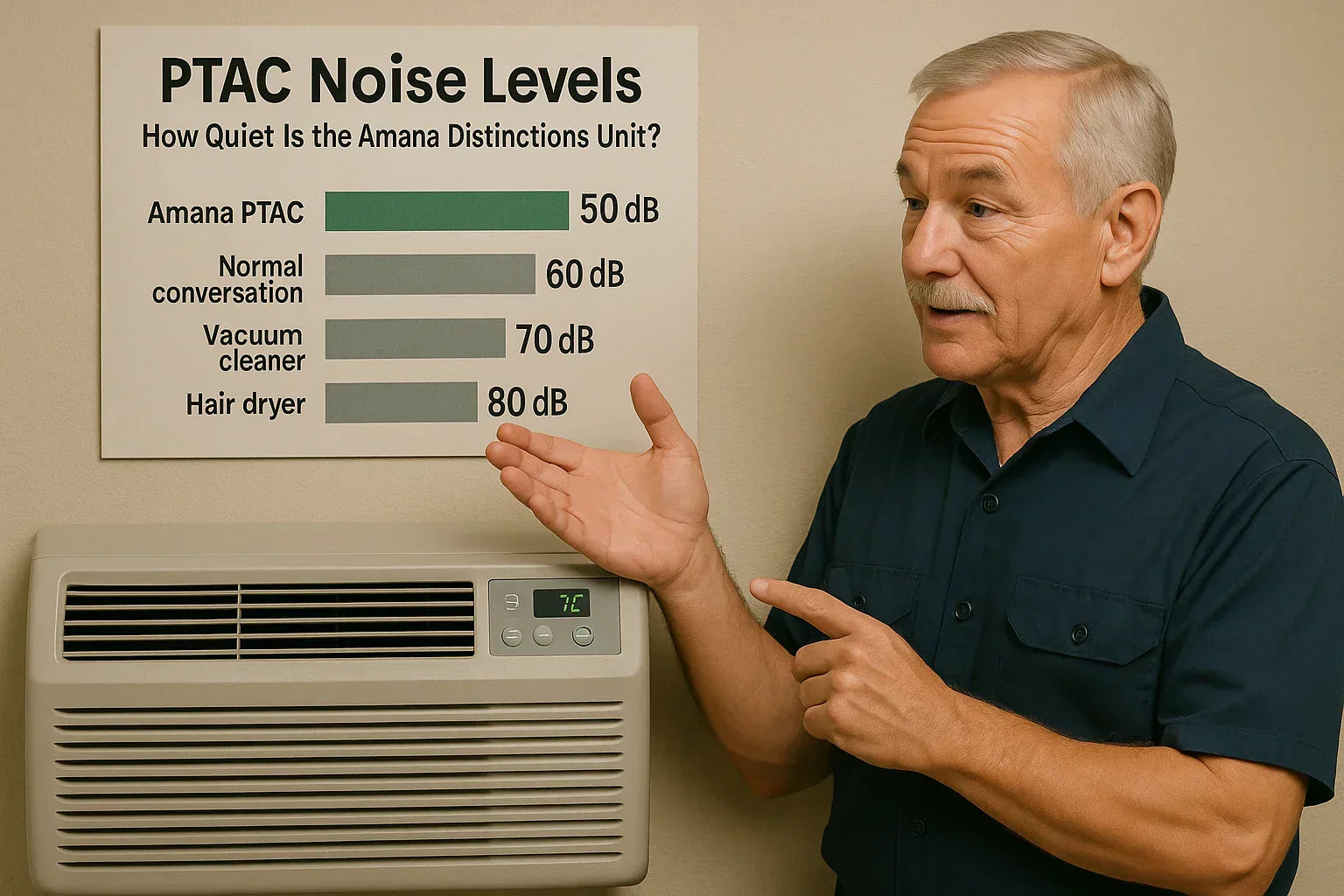🔊 Introduction: Comfort Isn’t Just Temperature
When you install a PTAC unit in a hotel, assisted living suite, or apartment, cooling and heating aren’t the only factors your guests will notice. Noise matters just as much.
I’m Tony Marino, and today we’re diving into how PTAC noise is measured, what causes it, how the Amana Distinctions 12,000 BTU PTAC compares to others, and most importantly—what you can do to keep these units running quietly.
📏 How PTAC Noise Levels Are Measured
The noise of HVAC equipment is measured in decibels (dB).
-
0 dB: Threshold of hearing
-
30 dB: Whisper
-
50 dB: Moderate conversation
-
60 dB: Busy office
-
70 dB: Vacuum cleaner
Most PTAC manufacturers list their units' indoor sound levels at various fan speeds:
-
Low fan speed: ~45–48 dB
-
High fan speed: ~50–54 dB
👉 The Amana Distinctions 12,000 BTU model typically runs between 46–52 dB depending on fan speed.
🏨 Why Noise Level Matters for Guest Experience
In hotels, apartments, or senior living suites, your occupants want:
-
Steady white noise (soft fan hum is acceptable)
-
No compressor thumps or rattles
-
No buzzing thermostats or relay clicks
Even small noises disrupt sleep quality and create complaints.
Cornell Hotel School Noise Impact Studies
⚙️ Main PTAC Noise Sources
1️⃣ Indoor Fan Motor: Blower speed, blade balance, dirt buildup
2️⃣ Compressor: Startup surge, shutdown rattle, refrigerant cycling
3️⃣ Reversing Valve: Noticeable during heating mode changeover
4️⃣ Airflow Obstructions: Dirty filters, misaligned grilles
5️⃣ Vibration: Loose mounting brackets or cabinet panels
Amana’s Design Improvements:
-
Quiet rotary compressors
-
Vibration-isolated mounts
-
Sealed fan compartments
-
Enhanced airflow pathways
Amana PTAC Sound Engineering Whitepaper
📊 Amana vs. Competitor PTAC Noise Levels
| Brand | Typical Range (Low - High Fan) |
|---|---|
| Amana Distinctions | 46–52 dB |
| GE Zoneline | 47–53 dB |
| Friedrich PTAC | 45–50 dB |
| LG PTAC | 46–52 dB |
👉 Amana performs solidly within the industry’s top tier of quiet PTACs.
Consumer Reports HVAC Noise Tests
🧰 How Installation Affects PTAC Noise
A perfectly quiet PTAC can still sound bad if installed improperly.
Poor Installation Creates:
-
Cabinet vibration against wall framing
-
Poor sleeve sealing creating air whistling
-
Loose grilles rattling during operation
-
Gaps allowing outdoor wind to transmit noise
Tony’s Installation Tips:
-
Use foam weather-stripping behind all metal contact points
-
Carefully level and secure the wall sleeve
-
Seal all perimeter gaps tightly
-
Avoid overly rigid mounting brackets that transmit vibration
Energy Star PTAC Installation Guide
🛠️ Ongoing Maintenance to Keep Noise Low
| Task | Frequency | Noise Benefit |
| Clean filters | Monthly | Keeps airflow smooth |
| Inspect fan blades | 6 months | Prevents imbalance |
| Tighten hardware | Annually | Stops cabinet rattle |
| Clean coils | Annually | Reduces compressor strain |
ASHRAE HVAC Maintenance Standards
🎧 Acceptable PTAC Noise Ranges by Application
| Facility Type | Target Noise Level |
| Upscale hotel suites | < 50 dB |
| Mid-tier hotels | < 52 dB |
| Senior living apartments | < 50 dB |
| Budget motels | < 54 dB acceptable |
| Hospital rooms | < 48 dB ideal |
👉 Amana Distinctions PTAC comfortably meets most of these standards when properly installed and maintained.
National Sleep Foundation Noise Studies:
✅ Tony’s Bottom Line
PTACs will never be absolutely silent. But properly installed and maintained modern models like the Amana Distinctions 12,000 BTU Heat Pump PTAC deliver extremely respectable noise performance.
For hotels, apartments, or assisted living:
-
46–52 dB operation is very acceptable.
-
Attention to installation quality makes all the difference.
-
Routine maintenance prevents small noises from growing into guest complaints.
Your HVAC system should make money, not noise. Get your PTACs right, and your guests sleep like babies.
In the next topic we will know more about: PTAC Rebates, Tax Credits, and Energy Incentives: What Can You Claim in 2025?







